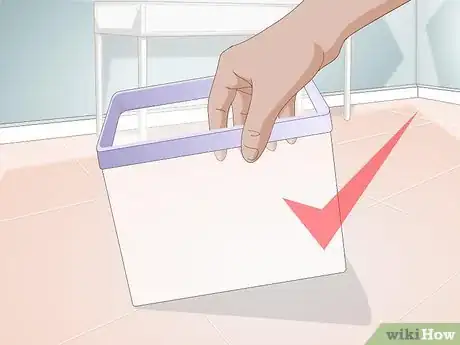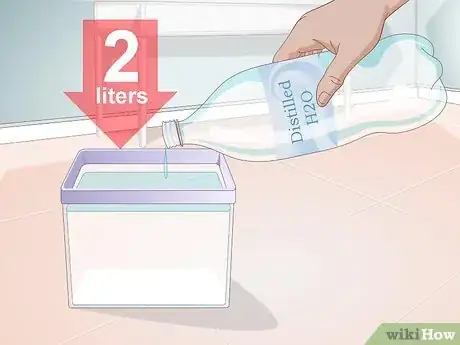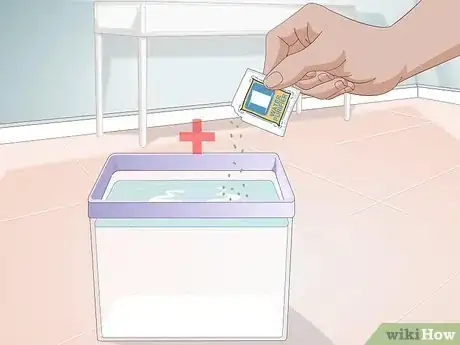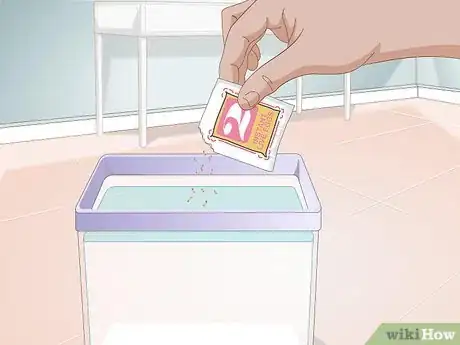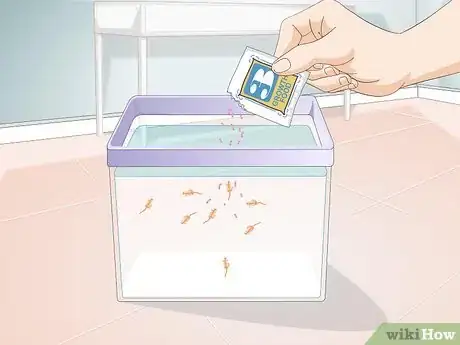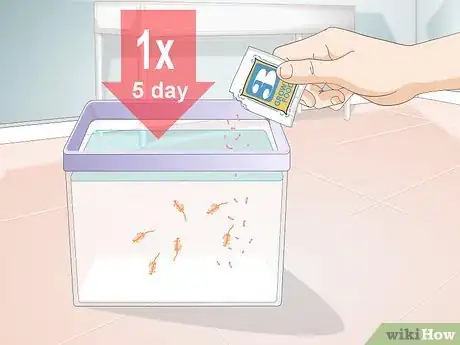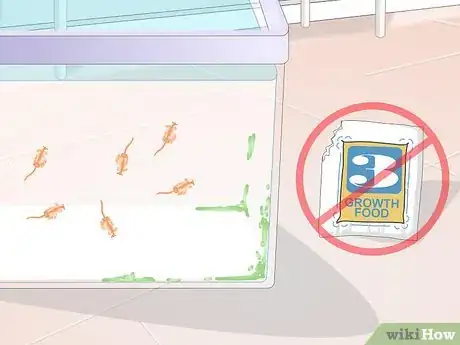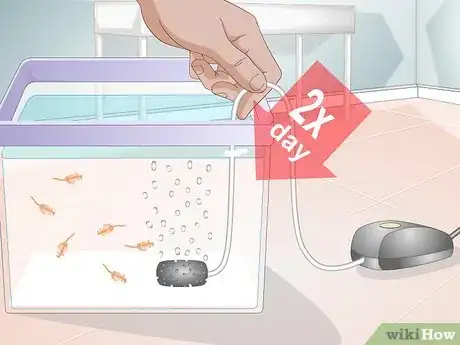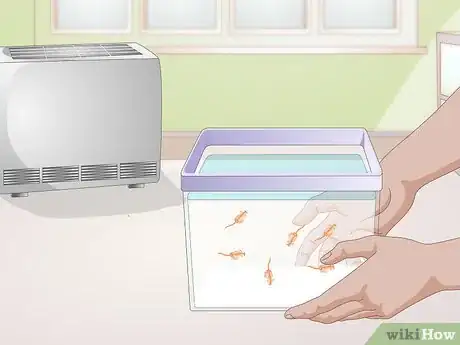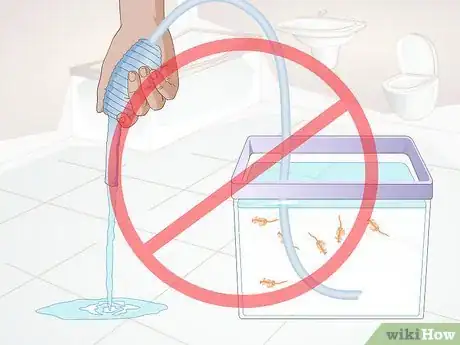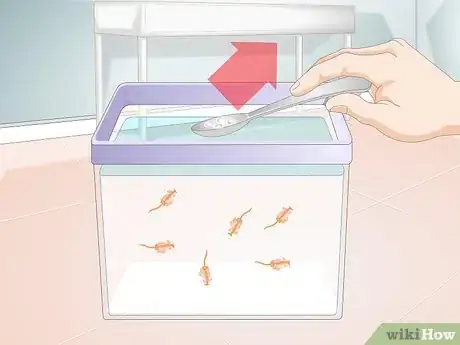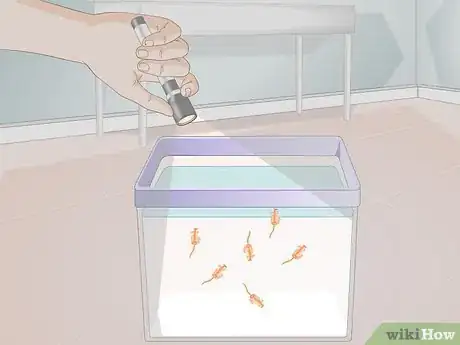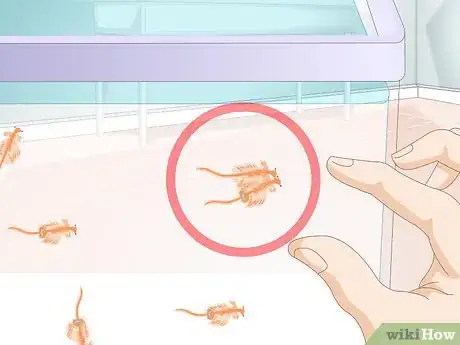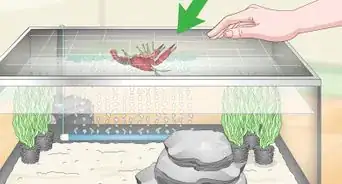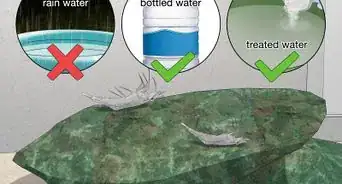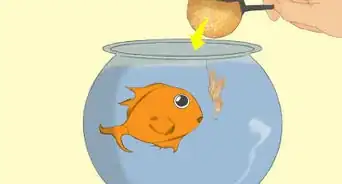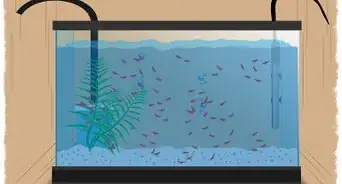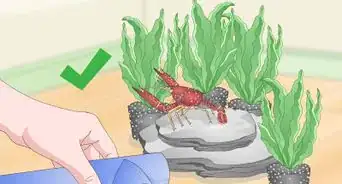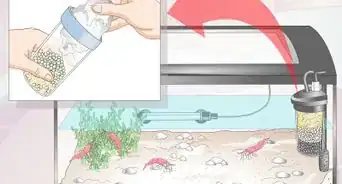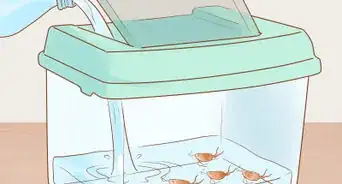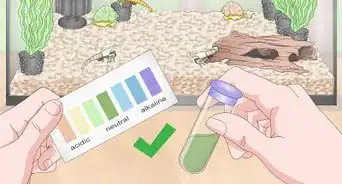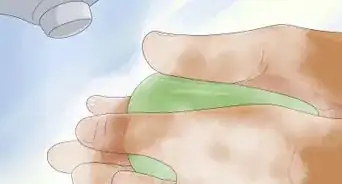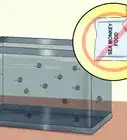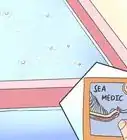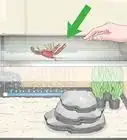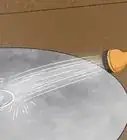This article was co-authored by Doug Ludemann. Doug Ludemann is the owner and operator of Fish Geeks, LLC, an aquarium services company based in Minneapolis, Minnesota. Doug has worked in the aquarium and fish-care industry for over 20 years, including having worked as a professional aquarist for the Minnesota Zoo and Shedd Aquarium in Chicago. He received his Bachelor of Science in Ecology, Evolution, and Behavior from the University of Minnesota.
wikiHow marks an article as reader-approved once it receives enough positive feedback. This article received 25 testimonials and 91% of readers who voted found it helpful, earning it our reader-approved status.
This article has been viewed 717,446 times.
Sea monkeys are not actually monkeys and they do not live in the sea. In fact, sea monkeys are a hybrid breed of brine shrimp created in the 1950s that soon became popular as easy to care for pets and an easy, nutritious live food for fish. [1] Sea monkeys are hatched in unchlorinated saltwater and usually appear within 24 hours. They will then develop into tiny translucent shrimp with tails that vaguely resemble the tail of a monkey.[2] Sea monkeys are low maintenance pets, but you need to keep the water clean and well-oxygenated at all times.
Steps
Setting Up the Tank
-
1Use a clean, plastic container. Many sea monkey kits will come with small plastic tanks you can use to hatch and house your sea monkeys. If your kit did not come with a small plastic tank, you can use a clean plastic container that can hold at least two liters of water. Look for a container that has a deep base, as sea monkeys often enjoy swimming around at the base area of their tanks.
-
2Fill it with two liters of distilled water. You can use bottled water, distilled water, or any form of unchlorinated water. Avoid using carbonated water or tap water, as it often contains fluoride and other minerals that may not be good for your sea monkeys.
- Once you fill the tank with the water, you should place the tank indoors so it can warm up to room temperature. This will ensure the water will be warm enough for the sea monkey eggs.
- You should also aerate the tank water at least once to twice a day with an air pump or a turkey baster.
Advertisement -
3Add the water purifier to the water. The water purifier or salt packet should come in your sea monkey kit when you buy it in stores or online. The water purifier will contain salt, which is important for your sea monkeys as it will allow them to hatch in the water and thrive.
- Once you put the salt packet in the water, give it a stir and let the water sit in room temperature for another day or up to 36 hours before you add the sea monkeys to the tank.
-
4Put the sea monkeys in the water and wait for them to hatch. Once you pour the sea monkeys into the tank, stir the tank water with a clean plastic spoon. The sea monkeys will appear as small dots in the water. But don’t worry, they will hatch in around five days and begin swimming around in the tank.
- Aerate the water while you wait for the sea monkeys to hatch, at least once to twice a day. This will ensure there is enough oxygen in the water for your sea monkeys as they develop and hatch.
Feeding the Sea Monkeys
-
1Start feeding the sea monkeys five days after they hatch. Rather than feed your sea monkeys as soon as they start hatching, you should wait five days. On the fifth day from when your sea monkeys hatch, you can give them sea monkey food. The sea monkey food should come with your sea monkeys as part of a kit.
- Use the small end of the feeding spoon to sprinkle one small spoonful of food in their tank. You should give them a small spoonful of food every 2 days. Do not give your sea monkeys fish food or foods other than sea monkey food.
-
2Give them sea monkey food every five days. You should feed your sea monkeys every five days to keep them healthy and happy. Do not overfeed your sea monkeys as this will often kill them.
- Sea monkeys are transparent, which means you will be able to see their digestive tract if you look at them closely. When their digestive tract is full of food, they will have a black stripe down the middle of their body. Once they poop out the food, their digestive tract will be clear again.
-
3Feed your sea monkeys less food once algae develops in the tank. Over time, green algae will start to appear in the tank. The tank may also smell grassy, like a freshly mowed lawn. These are all good signs, as the green algae actually acts as food for sea monkeys and helps them stay healthy. You can switch to feeding your sea monkeys once a week once green algae begins to form and build up in the tank.[3]
- You should also not worry about cleaning the tank once the algae starts to develop. The tank may look green and full of algae, but it is actually very healthy and good for your sea monkeys that way.
Maintaining the Tank
-
1Aerate the tank water twice a day. Your sea monkeys need oxygen to live happily in their tank. If they become oxygen deprived, they may turn a pinkish color and appear slow-moving or tired. To ensure the water has enough oxygen, you should aerate the tank twice a day, once in the morning and once at night. You can use an air pump to aerate the water, such as an air pump used in small aquariums. Stick the air pump in the water and let it aerate the tank for at least one minute, twice a day.
- Another option is to use a small turkey baster to aerate the tank. You can squeeze the turkey baster in the air and then put it in the water and release the air to put more oxygen in the water. Pull the turkey baster in and out of the water, placing air in the water, for at least one minute, twice a day.
- To make your own air bubbler: Take a pipette that you aren't planning on using for anything else. Poke a hole in the very top, then poke many tiny holes in the squirting-out end. Either use a pin or staple it several times from different angles with a stapler, then remove the staples.
- If you do not want to remember to aerate the tank twice a day, you can place a small live plant in the sea monkeys’ tank to provide oxygen in the water. Use an underwater aquarium plant that is known to provide good oxygen underwater.
-
2Place the tank in a warm place. Sea monkeys do best in a spot that's a little over room temperature.[4] You should put their tank in a spot of your house that gets indirect sunlight and is at least 22° Celsius (72° Fahrenheit). This will ensure the tank gets enough heat and is not too cold for your sea monkeys.
- A tank that is too cold will lead to them becoming immobile sea monkeys and sea monkeys that do not grow. If you notice the sea monkeys are not moving in their tank or growing, it could be because the tank is too cold and needs to be moved to a warmer spot in your home. Place it in a spot with indirect sunlight so it gets enough heat but does not get too hot.
-
3Do not change the water unless it smells very foul or appears cloudy. Green algae in the tank is a good thing, as the algae acts as food and provides oxygen for your sea monkeys. But if you notice the tank smells really bad and the water appears dark and cloudy, you may need to clean the tank and the water.
- You will need a coffee filter and a clean glass filled with unchlorinated saltwater. Use a net to take the sea monkeys out of the tank and place them in the clean glass with water.
- Place the coffee filter over a clean tank and run the tank water through the coffee filter several times. Try to filter out as much of the gunk in the water as possible.
- You can use a paper towel to clean out the bottom and sides of the tank. You can also use a Q-tip to clean out any gunk in the crevices of the tank.
- Smell the tank water to check that it no longer smells foul. Then, put the water back in the tank, followed by the sea monkeys. Top up the tank water with purified, room temperature water. Feed your sea monkeys and aerate the tank several times throughout the day. Then, feed them again five days later, per their usual feeding schedule.
Ensuring the Sea Monkeys are Healthy and Happy
-
1Watch for any white spots in the tank and remove them. If you notice white spots, almost like cotton balls, in the tank water, you should try to remove them as soon as possible. They are a type of bacteria that can kill your sea monkeys. Use a small spoon to get them out of the tank and dispose of them.
- You may want to also put Sea Medic into the tank, which will help to kill any remaining bacteria. If they still appear after one to two days, you should give the tank a thorough cleaning and replace the water. You may lose baby sea monkeys and sea monkey eggs when you dispose of the water, but this may be the only way to kill the bacteria.
-
2Use a small flashlight to make the sea monkeys dance and swim around. You can play with your sea monkeys using a small flashlight or a penlight. Move the light against the tank and note how the sea monkeys will chase and follow the light as you move it around. They will also gather by the light if you keep it still against the tank.
- You can have fun playing with your sea monkeys by drawing shapes and patterns with the light, which they will then swim around and trace in the tank.
-
3Note if the sea monkeys are mating. Male sea monkeys have whiskers under their chins and female sea monkeys often appear to be carrying eggs when they swim around. Sea monkeys will mate often so do not be surprised if you see sea monkeys latching onto each other as they swim. This is an indication your sea monkeys are mating and more sea monkeys will soon be on their way.
- Most sea monkeys live for an average of two years but due to their high mating rates, you will likely have a continuous supply of sea monkeys in the tank as long as you care for the tank and the sea monkeys properly.
Expert Q&A
Did you know you can get expert answers for this article?
Unlock expert answers by supporting wikiHow
-
QuestionCan you use tap water for sea monkeys?
 Doug LudemannDoug Ludemann is the owner and operator of Fish Geeks, LLC, an aquarium services company based in Minneapolis, Minnesota. Doug has worked in the aquarium and fish-care industry for over 20 years, including having worked as a professional aquarist for the Minnesota Zoo and Shedd Aquarium in Chicago. He received his Bachelor of Science in Ecology, Evolution, and Behavior from the University of Minnesota.
Doug LudemannDoug Ludemann is the owner and operator of Fish Geeks, LLC, an aquarium services company based in Minneapolis, Minnesota. Doug has worked in the aquarium and fish-care industry for over 20 years, including having worked as a professional aquarist for the Minnesota Zoo and Shedd Aquarium in Chicago. He received his Bachelor of Science in Ecology, Evolution, and Behavior from the University of Minnesota.
Aquarium Care Professional
-
QuestionSome of the sea monkeys are lying at the bottom of the tank. Are they dead?
 Community AnswerUnless your sea monkeys appear black in color, they are likely still alive. However, the water may be too cold for them. You should move the tank to a warmer spot in your home.
Community AnswerUnless your sea monkeys appear black in color, they are likely still alive. However, the water may be too cold for them. You should move the tank to a warmer spot in your home. -
QuestionWhen the sea monkeys have fully grown what do you do with them? Do you put them in a bigger tank?
 Community AnswerYou do not need to move sea monkeys to a new tank once they are full grown. They can remain in the same tank.
Community AnswerYou do not need to move sea monkeys to a new tank once they are full grown. They can remain in the same tank.
References
- ↑ http://www.livescience.com/33907-sea-monkeys.html
- ↑ http://animaldiversity.org/accounts/Artemia_salina/
- ↑ https://www.youtube.com/watch?v=sr5J0_FhObE
- ↑ Doug Ludemann. Aquarium Specialist. Personal interview. 27 August 2019.
About This Article
To care for sea monkeys, fill a tank with distilled or filtered water and then put in the sea monkey eggs. In about 5 days, they should hatch, and you can start feeding them 5 days after that. Feed them 1 small spoonful of food every 2-5 days, being careful not to overfeed them. Twice each day, you should aerate your tank, either with an automatic water pump or by sucking up water with a small turkey baster and squeezing it back in the tank. You can enjoy your sea monkeys for up to 2 years. To learn how to make a bubbler to aerate your tank, keep reading.
